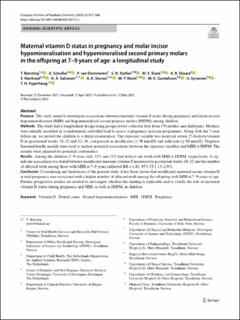| dc.contributor.author | Børsting, Torunn | |
| dc.contributor.author | Schuller, Annemarie | |
| dc.contributor.author | van Dommelen, Paula | |
| dc.contributor.author | Stafne, Signe Nilssen | |
| dc.contributor.author | Skeie, Marit Slåttelid | |
| dc.contributor.author | Skaare, Anne | |
| dc.contributor.author | Mørkved, Siv | |
| dc.contributor.author | Salvesen, Kjell Å | |
| dc.contributor.author | Stunes, Astrid Kamilla | |
| dc.contributor.author | Mosti, Mats Peder | |
| dc.contributor.author | Gustafsson, Miriam Katarina | |
| dc.contributor.author | Syversen, Unni | |
| dc.contributor.author | Fagerhaug, Tone Natland | |
| dc.date.accessioned | 2023-01-26T15:20:40Z | |
| dc.date.available | 2023-01-26T15:20:40Z | |
| dc.date.created | 2022-05-13T13:28:02Z | |
| dc.date.issued | 2022 | |
| dc.identifier.citation | European Archives of Paediatric Dentistry. 2022, 23 (4), 557-566. | en_US |
| dc.identifier.issn | 1818-6300 | |
| dc.identifier.uri | https://hdl.handle.net/11250/3046678 | |
| dc.description.abstract | Purpose
The study aimed to investigate associations between maternal vitamin D status during pregnancy and molar incisor hypomineralisation (MIH) and hypomineralised second primary molars (HSPM) among children.
Methods
The study had a longitudinal design using prospectively collected data from 176 mother and child pairs. Mothers were initially recruited in a randomised controlled trial to assess a pregnancy exercise programme. Along with the 7-year follow-up, we invited the children to a dental examination. The exposure variable was maternal serum 25-hydroxyvitamin D in gestational weeks 18–22 and 32–36, categorised as insufficient (< 50 nmol/l) and sufficient (≥ 50 nmol/l). Negative binomial hurdle models were used to analyse potential associations between the exposure variables and MIH or HSPM. The models were adjusted for potential confounders.
Results
Among the children (7–9 years old), 32% and 22% had at least one tooth with MIH or HSPM, respectively. A significant association was found between insufficient maternal vitamin D measured in gestational weeks 18–22 and the number of affected teeth among those with MIH at 7–9 years (adjusted RR = 1.82, 95% CI 1.13–2.93).
Conclusion
Considering any limitations of the present study, it has been shown that insufficient maternal serum vitamin D at mid-pregnancy was associated with a higher number of affected teeth among the offspring with MIH at 7–9 years of age. Further prospective studies are needed to investigate whether this finding is replicable and to clarify the role of maternal vitamin D status during pregnancy and MIH, as well as HSPM, in children. | en_US |
| dc.language.iso | eng | en_US |
| dc.publisher | Springer | en_US |
| dc.rights | Navngivelse 4.0 Internasjonal | * |
| dc.rights.uri | http://creativecommons.org/licenses/by/4.0/deed.no | * |
| dc.title | Maternal vitamin D status in pregnancy and molar incisor hypomineralisation and hypomineralised second primary molars in the offspring at 7–9 years of age: a longitudinal study | en_US |
| dc.title.alternative | Maternal vitamin D status in pregnancy and molar incisor hypomineralisation and hypomineralised second primary molars in the offspring at 7–9 years of age: a longitudinal study | en_US |
| dc.type | Peer reviewed | en_US |
| dc.type | Journal article | en_US |
| dc.description.version | publishedVersion | en_US |
| dc.source.pagenumber | 557-566 | en_US |
| dc.source.volume | 23 | en_US |
| dc.source.journal | European Archives of Paediatric Dentistry | en_US |
| dc.source.issue | 4 | en_US |
| dc.identifier.doi | 10.1007/s40368-022-00712-y | |
| dc.identifier.cristin | 2024384 | |
| cristin.ispublished | true | |
| cristin.fulltext | original | |
| cristin.qualitycode | 1 | |

